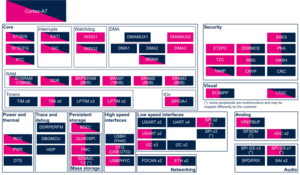1. Article purpose[edit source]
The purpose of this article is to:
- briefly introduce the DDRMCE peripheral and its main features
- indicate the level of security supported by this hardware block
- explain how to configure the DDRMCE peripheral.
2. Peripheral overview[edit source]
The DDRMCE (DDR Memory Cipher Engine) peripheral allows to defined one AES encrypted region in DDR memory.
2.1. Features[edit source]
Refer to STM32MP13 reference manuals for the complete list of features, and to the software components, introduced below, to know which features are really implemented.
DDRMCE 128-bit master key is provisioned during boot processing, in order to use AES[1] block ciphering feature. It must be fully saved in Backup RAM for low power sequences.
2.2. Security support[edit source]
DDRMCE is a securable peripheral (under ETZPC control).
3. Peripheral usage and associated software[edit source]
3.1. Boot time[edit source]
The DDRMCE, part of the DDR subsystem, is configured inside TF-A BL2 to setup the security of a DDR region. This should be done before accessing DDR region if encryption is required.
3.2. Runtime[edit source]
3.2.1. Overview[edit source]
All system bus traffic going through an encrypted region is managed on-the-fly by the DDRMCE, automatically decrypting reads and encrypting writes.
3.2.2. Software frameworks[edit source]
| Domain | Peripheral | Software components | Comment | |
|---|---|---|---|---|
| OP-TEE | Linux | |||
| RAM/Security | DDRMCE | Memory mapping | ||
3.2.3. Peripheral configuration[edit source]
The DDRMCE configuration is generated via STM32CubeMX tool, according to the region characteristics (address, length, type). This configuration is applied during boot time by the FSBL (see Boot chain overview): TF-A.
3.2.4. Peripheral assignment[edit source]
Click on the right to expand the legend...
| Domain | Peripheral | Runtime allocation | Comment | ||
|---|---|---|---|---|---|
| Instance | Cortex-A7 secure (OP-TEE) |
Cortex-A7 non-secure (Linux) | |||
| Security | DDRMCE | DDRMCE | ✓ | ✓ | |
4. References[edit source]
